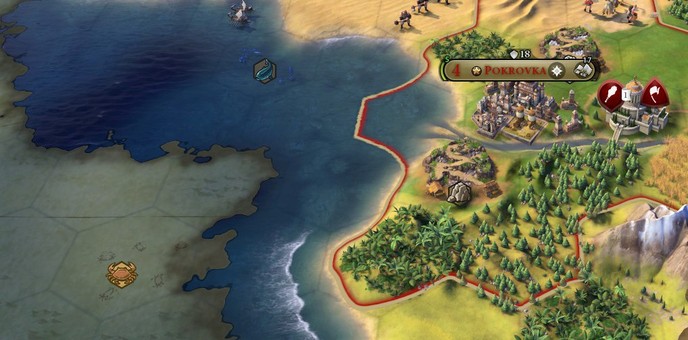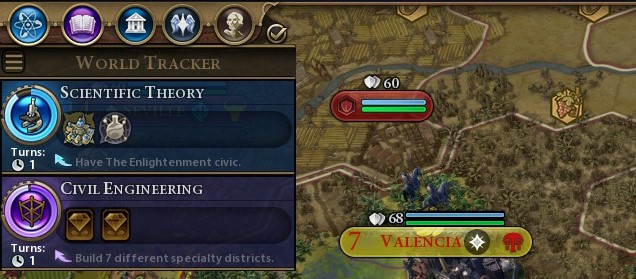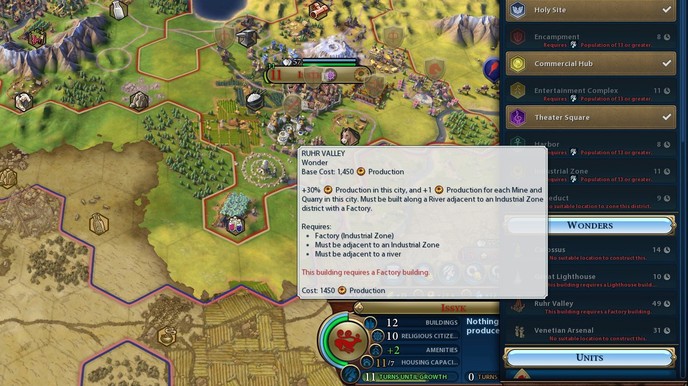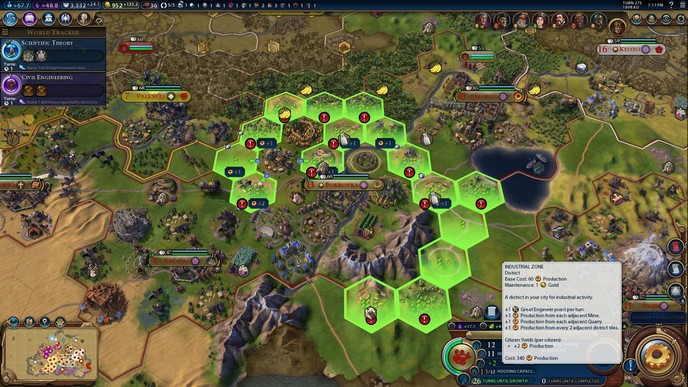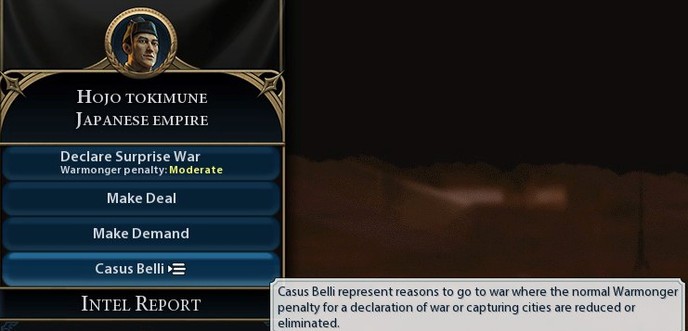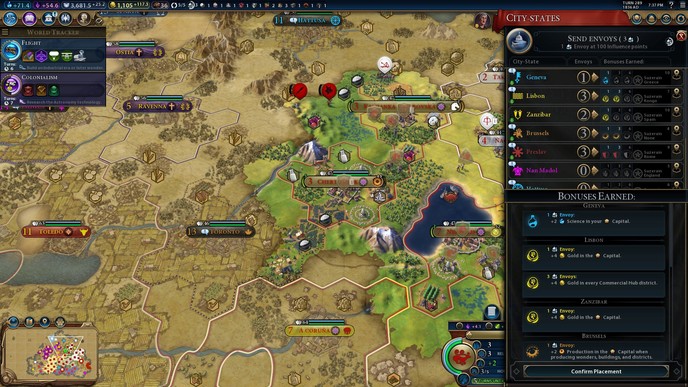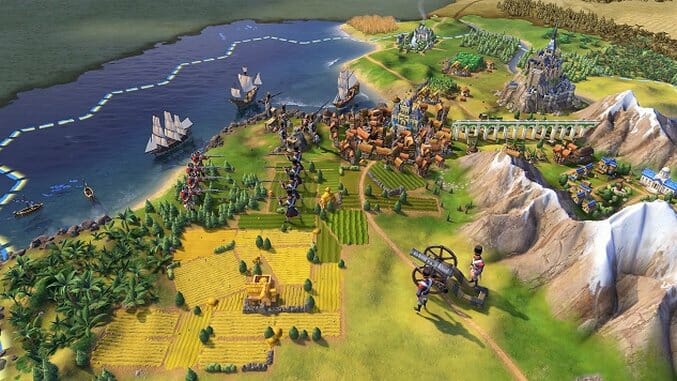
It has been six years since the release of Civilization V, and somehow, with the arrival of its successor, I still don’t feel ready. The series, with its intricate web of interdependent factors, is notoriously difficult to learn. While my friends see the hundreds of hours of investment as evidence of my expertise, on the contrary, I know just enough to know I know nothing.
Be that as it may, the twenty hours I’ve put in does make it easy to spot the changes made to this latest iteration of the strategy game series, and predictably, they are numerous. What takes me by surprise however is that most of them make sense in the greater context of the game’s systems, and how easily they are adapted into the existing features. Some were first tested in Civilization: Beyond Earth (which admittedly did not deviate far enough from Civilization V) and since then have been polished along with other weak points to make a more refined game. So far, I like what I see.
Of the superficial changes to the game, I’m a fan. The new interface does a much better job of driving home the series’ theme of exploration. The map elements are especially enchanting, evoking the old world charm of cartography and sea navigation. Sepia and faint ink give way to full color and rich details as Scouts make the nearby areas visible to your civilization. Unit icons, with their dotted lines and compass markings, reinforce the sense that you’re mapping a new world for the very first time.
With this aesthetic update comes an improved emphasis on exploring and making strategic use of the nearby land and its geological features. For example meeting other civilizations or finding World Wonders will now bring advancements that discover or speed along the progress of developing new technologies, like Writing or Astrology. Completing certain challenges will also boost the production of a technology, drastically reducing the necessary turns to develop it in full.
The Tech tree, through which your civilization progresses its knowledge of science and receives new units, buildings, and boosts, has been split into two, now offering a Civics tree to invest in as well. Both the Tech and Civics tree can be boosted by achieving small accomplishments as listed on the icon. They can also be boosted or awarded by villages and settlements you find with your explorers, strongly reinforcing the importance of exploration with Scout units early in the game.
The Social Policies Tree has also been completely overhauled, divided into Legacy Bonuses (which stay with your civilization throughout the game), Policy Agenda, and Government. Ideologies, referred to as “Governments”, are folded into a different tab and cover former Social Policy Tree items like Democracy and Autocracy with new entries like Monarchy and Fascism. The Government you choose (and the Civic and Technology Tree tiers you invest into) will dictate how many Military, Economic, and Diplomatic policies will be available to you and how they can be used. For example Classical Republic government does not allow for a Military Policy to be selected, however two slots are allowed for Economic policies, one for Diplomatic, and another “Wildcard” slot that can be used for a policy of any ideology. The different policies, with their varying civilization bonuses, are represented by cards that are collected as you gain new technologies, and together they comprise your Policy Agenda. They can be changed to suit the needs of your settlements each time you gain a new card.
As for the new landscape features, the hexagonal tiles remain. Map pins can now be used to mark important areas, with customizable labels and icons. Roads no longer have to be built and instead will form on their own from trade routes. When you place a Settler, the overworld menu will now show a water availability guide to help you choose where to place your next city according to nearby resources. Escort Formation, a new command, will sync a nearby military unit with a Settler to accompany them as they travel and protect from hostile units. World Wonders now have advanced specifics for building in your cities, which adds to the challenge of strategically building them; you’ll not only need to memorize which are the most useful and how to develop for them in the Tech and Civics trees, but also take into account the land features they require. For example the Venetian Arsenal must be adjacent to an Industrial Zone, and built on the coast, and cannot be built on a lake. The Ruhr Valley requires a Factory be built in the city where it will be built, and must be adjacent both to a river and an Industrial Zone. World Wonders will also take up an entire tile of their own.
Districts, perhaps the most marketed new feature to Civilization, will add to the difficulty of strategically building and placing your World Wonders and tile upgrades. Each will take up one space on the map, and within them contain all the buildings associated with that District’s theme. For example, all the Banking related buildings reside in the Commerce District, the arts buildings in the Entertainment District, and so on. I’m not sure how I feel about this feature yet, but as it does not require an enormous amount of effort in shifting my previously established strategies, it does not bother me.
A new factor in managing your cities is Housing, which reflects the amount of room you have for Citizens, who work your tiles. If you do not provide enough Housing, your cities will not grow. In practice, this system does a fair job at reinforcing the importance of growth in your civilizations. Your Citizens now also require Amenities, which contribute to their overall Happiness. Should they go without Amenities for prolonged periods of time, they will stage a revolt.
One of the biggest game-changers actually comes via the Workers, which are no longer permanent units. Now known as Builders, they operate much like the Explorers of Civilization: Beyond Earth, in that they can only be used a limited number of times (though that number can be expanded through certain tree investments as time goes on). They also don’t require turns to make tile improvements, instead building them instantly.
I’m particularly fond of the improvements made to the Unit upgrade system, which is now delivered through a simple menu tree outlining the bonuses your Units can receive as they gain experience in battle. Whereas in Civilization V and even Beyond Earth (which also improved the Unit upgrade system) I tried to blast through choosing an upgrade as quickly as possible, now my choices are methodic and well-planned. As a result my Scouts are lasting much longer.
I’m also pleased with some of the clarification with regards to the use of Great Person and Great Person slots. Now when a Great Person spawns, they have to be physically moved and assigned to a related building with a free slot open of their type (for example, a Great Scientist must be moved to a University before they can be used to enhance your civilization). This feature existed somewhat before but now that it’s visualized, I find it easier to use strategically.
In general it’s nice to see how neatly the content of the Civilzation V expansions has been folded into and improved upon in the Civilization VI base game. For example there hasn’t been a huge upset in the Spy system but what improvements have been made are subtle and effective. Spies must now be “built” like other Units after researching the appropriate tech, and once they’ve been planted in a city, they can take on specific missions with varying bonuses upon completion. If caught, they will now be forced to flee the city they’re inhabiting, with various options for travel. Captured spies can also be retained and used in negotiation deals with other civilizations, exchanging prisoners for resources and gold.
Diplomacy improvements include a row of avatars using literal emoticons to indicate your status with each leader, which will bob or dip as you turn over into the next turn if your status has changed with them as a result of any recent actions. This small visual change makes it much easier to keep track of (and thus actually care about) your status with other world leaders. There’s also a new option called Casus Belli, which allows you to declare war on another civilization with reduced penalties based on justifications like ideological differences. Depth has been added to the City-States system with the addition of Envoys, which award bonuses based on the number of connections made between a civilization and a City-State.
Save for the new cartoonish look of the world leaders, an aesthetic that I think robs the series of its austerity, I’m satisfied with the game’s changes so far. Some of the tweaks do a solid job at reinforcing emphasis on key strategies and overall Civilization VI is better at teaching the game that its predecessors. It also excels at preserving and building upon the core values of its predecessor while improving on some key areas in an unobtrusive way. Having only played the preview, I already “can’t go back” to Civilization V. I look forward to the full game’s release on October 21.
Holly Green is a reporter, editor, and semiprofessional photographer living in Seattle, WA. She is also the author of Fry Scores: An Unofficial Guide To Video Game Grub. You can find her work at Gamasutra, Polygon, Unwinnable, and other videogame news publications.
